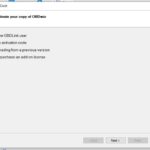Navigating car troubles can be frustrating, especially when the check engine light illuminates. Understanding what’s happening under the hood is crucial for both car enthusiasts and everyday drivers. The Autel Maxiscan Ms509 Obd2 Scanner emerges as a powerful yet user-friendly tool designed to demystify your vehicle’s health. This handheld device empowers you to quickly and accurately diagnose car problems, read error codes, and ensure your vehicle is running smoothly. Whether you’re a seasoned mechanic or a DIY enthusiast, the MS509 is crafted to simplify automotive diagnostics.
What is the Autel MaxiScan MS509 OBD2 Scanner?
The Autel MaxiScan MS509 OBD2 Scanner is an essential tool in the realm of automotive diagnostics. OBD2, or On-Board Diagnostics II, is a standard in most modern vehicles (1996 and newer in the USA) that provides access to vital vehicle system information. The MS509 is a code reader that plugs into your car’s OBD2 port, allowing you to communicate with your car’s computer. It’s designed to read Diagnostic Trouble Codes (DTCs), which are essentially error messages generated by your vehicle’s engine control unit (ECU) when it detects a problem. This scanner is built for ease of use, making complex car diagnostics accessible to both professional technicians and car owners at home.
Key Features and Functions of the MaxiScan MS509
The Autel MaxiScan MS509 is packed with features that make diagnosing car issues straightforward and efficient:
-
Broad Vehicle Compatibility: It works with all OBDII compliant vehicles manufactured from 1996 onwards, including US, European, and Asian models. This wide compatibility ensures that you can use it on most modern cars and light trucks.
-
Check Engine Light Diagnosis (MIL): The primary function of the MS509 is to determine why your check engine light (Malfunction Indicator Lamp – MIL) is on. It quickly identifies the source of the problem, saving you time and potential guesswork.
-
Comprehensive Code Reading: The scanner retrieves both generic (P0, P2, P3, and U0) and manufacturer-specific (P1, P3, and U1) codes. Generic codes are standard across all manufacturers, while manufacturer-specific codes provide more detailed information unique to your car’s brand.
-
Code Clearing and Monitor Reset: After diagnosing and fixing the issue, the MS509 allows you to turn off the check engine light, clear the stored codes, and reset OBDII monitors. This is essential to confirm the repair is effective and to reset the system.
-
DTC Definitions Display: Instead of just showing a code, the MS509 displays clear and concise definitions of the DTCs directly on its screen. This feature helps you understand the meaning of the code without needing to look it up separately.
-
Freeze Frame Data: When an emission-related fault occurs, the vehicle’s computer records a snapshot of the operating conditions. The MS509 can access this “freeze frame data,” providing valuable context for diagnosing intermittent problems.
-
I/M Readiness Status: This function checks the emission system monitors on your vehicle and tells you if they are ready for an emission test. It helps ensure your car will pass smog checks and indicates the status of crucial emission-related systems.
-
Live Data Stream: The MS509 can display real-time live data from your vehicle’s sensors. This includes information like engine RPM, coolant temperature, O2 sensor readings, and more. Live data is invaluable for understanding how your engine is performing in real-time.
-
O2 Sensor Test Data: Specifically, the scanner can display live O2 sensor test data. Oxygen sensors are critical for engine efficiency and emissions, and this feature helps in diagnosing issues related to them.
-
Data Graphing: For vehicles manufactured in 1996 and newer, the MS509 can graph live data. Visualizing data in graph form makes it easier to identify trends and anomalies in sensor readings.
-
Data Playback: The device can read, store, and playback live sensor data. This is useful for reviewing data at a later time or comparing data from different driving conditions.
-
Multilingual Support: The MS509 offers multilingual menus and DTC definitions in English, Spanish, French, German, and Dutch, catering to a diverse user base.
-
Module Present Test: This feature allows you to identify the modules present in your vehicle’s network, helping to understand your car’s electronic architecture.
-
Vehicle Information Retrieval (VIN, CIN, CVN): The scanner can retrieve important vehicle information such as the Vehicle Identification Number (VIN), Calibration Identification Number (CIN), and Calibration Verification Number (CVN). This information can be useful for vehicle identification and service purposes.
-
CAN and OBD-II Protocol Support: The MS509 supports CAN (Controller Area Network) and all other current OBD-II protocols, ensuring compatibility with a wide range of vehicles and communication standards.
-
Built-in DTC Lookup Library: The scanner has a built-in OBD-II DTC lookup library, eliminating the need for external code books or internet searches for code definitions.
-
Large LCD Screen: Equipped with a large, easy-to-read backlit LCD screen, the MS509 ensures clear visibility of test results, even in varying lighting conditions.
-
Software Upgradeable: The MS509’s software is upgradeable via the internet, ensuring that your tool stays current with the latest vehicle models and diagnostic capabilities.
-
PC Printing: The scanner allows you to print data via PC, enabling you to keep records of diagnostic reports for your car’s maintenance history.
Understanding the MS509’s Design and Components
The Autel MaxiScan MS509 is designed for intuitive operation and durability. Key components include:
-
LCD Display: The backlit 128 x 64 pixel LCD screen displays test results and menu options clearly. The contrast adjustment feature ensures readability in different lighting environments.
-
ENTER Button: This button confirms selections from menus and initiates actions, such as starting live data recording in manual trigger mode.
-
ESC Button: The ESC button cancels selections, returns to previous menus, exits the DTC Lookup screen, and stops data recording.
-
LEFT/RIGHT SCROLL Buttons: These buttons are used for navigation within menus, viewing additional information for DTC definitions spanning multiple screens, and selecting/deselecting PIDs (Parameter IDs) when customizing live data displays. They also navigate through frames during data playback.
-
UP/DOWN SCROLL Buttons: These buttons facilitate vertical navigation through menus and submenus. They are also used to scroll through multiple screens of data when retrieved. The DOWN button doubles as a language setup hotkey.
-
HELP Button: Pressing the HELP button provides context-sensitive help information, guiding users through various functions and features.
-
OBD II Connector: This is the physical interface that connects the scan tool to the vehicle’s Data Link Connector (DLC), establishing communication with the car’s computer.
-
Rubber Boot: The protective rubber boot encases the scanner, providing protection against drops, abrasions, and impacts, enhancing its durability in a workshop environment.
Vehicle Compatibility: Is the MaxiScan MS509 Right For Your Car?
The MaxiScan MS509 is designed to be universally compatible with OBDII compliant vehicles. Here’s what you need to know to verify compatibility:
-
OBDII Compliance is Mandatory: In the United States, all cars and light trucks sold from 1996 onwards are required by the EPA to be OBDII compliant. This standard applies to domestic, Asian, and European vehicles.
-
Checking Older Vehicles: While most 1994 and 1995 gasoline vehicles are not OBDII compliant, some exceptions exist. To check if your 1994 or 1995 vehicle is compliant, locate the Vehicle Emissions Control Information (VECI) Label. This label is usually found under the hood or near the radiator. If your vehicle is OBDII compliant, the label will clearly state “OBD II Certified.”
-
The 16-Pin DLC Connector: A key requirement for OBDII compliance is the presence of a standardized 16-pin Data Link Connector (DLC). This connector is typically located under the dashboard on the driver’s side. Your vehicle must have this 16-pin DLC to be compatible with the MS509 and other OBDII scanners.
To ensure your vehicle is OBDII compliant, check for the 16-pin DLC under the dash and confirm that the Vehicle Emission Control Information Label indicates OBDII certification.
Supported OBD2 Protocols
The MaxiScan MS509 supports a wide array of OBD-II protocols, ensuring broad compatibility:
- ISO 15765-4 CAN (29 bit ID, 250 kbaud)
- ISO 15765-4 CAN (11 bit ID, 250 kbaud)
- ISO 15765-4 CAN (29 bit ID, 500 kbaud)
- ISO 15765-4 CAN (11 bit ID, 500 kbaud)
- ISO 14230-4 KWP 2000 (fast init, 10.4 kbaud)
- ISO 14230-4 KWP 2000 (5 baud init, 10.4 kbaud)
- ISO 9141-2 (5 baud init, 10.4 kbaud)
- SAE J1850 VPW (10.4 kbaud)
- SAE J1850 PWM (41.6 kbaud)
This comprehensive protocol support means the MS509 can communicate effectively with the ECUs of most OBDII compliant vehicles, regardless of make or model.
Troubleshooting Common Issues
Encountering issues with your scan tool can be frustrating. Here are solutions to common problems you might face with the MaxiScan MS509:
Vehicle Linking Error: If the MS509 fails to communicate with your vehicle’s ECU, check the following:
- Ignition Status: Ensure the vehicle’s ignition is turned ON. The scanner needs power to communicate.
- Connector Security: Verify that the MS509’s OBD II connector is securely plugged into the vehicle’s DLC. A loose connection can prevent communication.
- OBD2 Compliance: Double-check that your vehicle is indeed OBD2 compliant, especially if it’s a model from the mid-1990s.
- Reset and Retry: Turn the ignition OFF, wait for about 10 seconds, then turn it back ON and try the diagnostic process again.
- Control Module Defect: In rare cases, the vehicle’s control module might be defective. If other steps fail, consider this possibility and consult a professional if needed.
Operating Error: If the scan tool freezes or becomes unresponsive, it could be due to an exception or a slow ECU response.
- Reset the Tool: Press and hold the POWER button for at least 2 seconds to reset the MS509. This often resolves temporary freezes.
- Restart Vehicle System: Turn the ignition OFF, wait 10 seconds, and then turn it back ON before resuming testing.
Scan Tool Doesn’t Power Up: If the MS509 fails to power on:
- Check DLC Connection: Ensure the OBD II connector is firmly connected to the vehicle’s DLC. The scanner draws power from the vehicle.
- Inspect DLC Pins: Check the DLC pins for any bending or breakage. Damaged pins can disrupt power and communication. Clean the DLC pins if necessary to ensure good contact.
MS509 Specifications
- Display: Backlit, 128 x 64 pixel display with contrast adjustment
- Operating Temperature: 0 to 60°C (32 to 140°F)
- Storage Temperature: -20 to 70°C (-4 to 158°F)
- External Power: 8.0 to 18.0 V power provided via vehicle battery
- Dimensions: 178 mm (Length) x 95 mm (Width) x 35 mm (Height)
(MS509 with USB & Print Function) Package Contents:
- 1 x MS509 Main Unit
- 1 x OBD2 Cable
- 1 x USB Cable
- 1 x User Manual
- 1 x CD (Software/Manual)
- 1 x Package Bag
Conclusion
The Autel MaxiScan MS509 OBD2 Scanner is a valuable investment for anyone looking to understand and maintain their vehicle’s health. Its comprehensive features, broad vehicle compatibility, and user-friendly design make it an excellent tool for diagnosing car problems, reading and clearing codes, and ensuring your vehicle is running efficiently. Whether you are tackling a persistent check engine light or simply want to stay informed about your car’s condition, the MS509 empowers you with the diagnostic capabilities you need.

